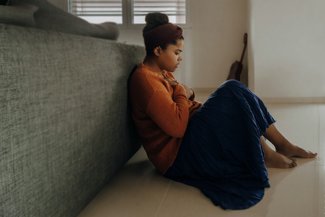
Underexamined and Underreported
Agenda Alliance's briefing on the links between intimate partner violence, suicidality (suicide attempts and suicidal thoughts), and self-harm.

27 Feb 2023
By Nia Clark, Senior Research and Engagement Officer
Every woman and girl’s life that is taken by domestic abuse is a pernicious stain upon our society. In public discourse and across the media, these deaths are often treated as isolated events; however, every woman’s life lost to male violence forms part of a pattern, a relentless repetition of male violence.
This month, the ONS released its latest analysis on homicide which show that the number of women dying from homicide increased from 160 to 198 in the last year. Further, 33% of these women were killed by a partner or ex-partner. The Femicide Census shows that the number of women dying as a result of fatal male violence has consistently hovered between 124 and 168 per year since they began monitoring numbers in 2009.
As confronting and harrowing as these numbers are, they are likely to be an underestimate: many women dying by suicide are "hidden victims" of domestic abuse. Domestic abuse frequently remains unidentified in coroners’ reports when women die by suicide following experience of domestic abuse. Therefore, as it stands, women who die from domestic abuse-related suicides are most often not counted within statistics on domestic abuse: in many ways these women are overlooked by the system even in death. Our Agenda Alliance briefing on the links between intimate partner violence and suicidality sheds light on the underexamined linkages between the two domains.
For too long, women who take their own lives following domestic abuse have not been adequately considered within national strategies on suicide prevention and violence against women and girls. However, the forthcoming suicide prevention strategy presents an important and timely opportunity to address this. Furthermore, it is promising that the Government’s Tackling Domestic Abuse Plan (2022) explicitly pledges to reduce rates of domestic abuse, domestic homicides, and suicides linked to domestic abuse.
To respond to these connections, policy must prioritise reducing the risk of domestic abuse and better supporting those most at risk. Women are at greater risk of domestic abuse-related suicidality and this disproportionality is exacerbated by experiences of multiple unmet needs and poverty. Additionally, Government must address the dearth of policy and evidence addressing the link between domestic abuse and suicide. By developing the evidence base, the nuances of the issue can be better understood, and higher risk population groups better protected.
In tandem with this, we need to see changes to the criminal justice and coronial systems to ensure that suicides in the context of domestic abuse are properly investigated. In 2022, a coroner explicitly made the link between domestic abuse and suicide in the case of one woman, Jessie Laverack, who died by suicide following domestic abuse from her former partner. The coroner highlighted that the lack of understanding about this interplay led to multiple failings in her care.
Sophie Naftalin, Partner at Bhatt Murphy Solicitors, acted for the family of Jessie Laverack. She stated:
"There needs to be a greater understanding of how domestic abuse poses a risk to life, not just from violent perpetrators but also as a result of the impact on mental health and suicidality. The Agenda Alliance research is helpful in establishing an evidence base for the clear connection between domestic abuse and suicidality. Inquests have a key role to play in scrutinising sudden deaths or apparent suicides that take place in the context of domestic abuse, but in order for that to be possible there needs to be greater recognition of domestic abuse and its impact on mental health: not only by coroners but also within the criminal justice, healthcare and safeguarding systems."
To ensure that the scale and severity of domestic abuse in the UK is understood properly, the links between domestic abuse and suspected victim suicides must be adequately investigated and recorded. To allow coroners to consistently capture the history of domestic abuse in suspected victim suicides, we need to see immediate changes made to the ways in which police investigate unexpected deaths and suspected suicides. If domestic abuse was acknowledged within coroners’ reports, current statistics relating to the number of women dying because of domestic abuse would likely rise.
As such, there needs to be greater training for police and emergency responders to ensure that domestic abuse indicators are routinely considered in cases of unexpected deaths or suspected suicides. Without this, potentially suspicious deaths will continue to be inadequately investigated and perpetrators will not be brought to justice.
To achieve this, Agenda Alliance are calling for all relevant government and policing bodies to enact change:


Agenda Alliance's briefing on the links between intimate partner violence, suicidality (suicide attempts and suicidal thoughts), and self-harm.

Agenda Alliance has today published rare data revealing the link between self-harm, suicidal thoughts and attempts and women’s experience of domestic abuse from a partner.